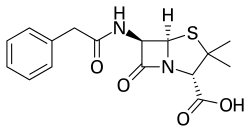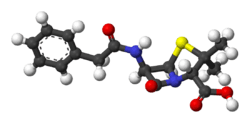Benzylpenicillin
Benzylpenicillin, also known as penicillin G, is an antibiotic used to treat a number of bacterial infections.[2] This includes pneumonia, strep throat, syphilis, necrotizing enterocolitis, diphtheria, gas gangrene, leptospirosis, cellulitis, and tetanus.[2] It is not a first-line agent for pneumococcal meningitis.[2] Benzylpenicillin is given by injection into a vein or muscle.[1] Two long-acting forms benzathine benzylpenicillin and procaine benzylpenicillin are available for use by injection into a muscle.[2]
 | |
 Ball and stick model. Legend: Blue=nitrogen; red=oxygen; yellow=sulfur black=carbon and carbon bonds; white=hydrogen | |
| Clinical data | |
|---|---|
| Trade names | Pfizerpen, other |
| Other names | penicillin G potassium,[1] penicillin G sodium |
| AHFS/Drugs.com | International Drug Names |
| MedlinePlus | a685013 |
| Pregnancy category | |
| Routes of administration | IV, IM |
| ATC code | |
| Legal status | |
| Legal status |
|
| Pharmacokinetic data | |
| Protein binding | 60 % |
| Metabolism | Liver |
| Elimination half-life | 30 min |
| Excretion | Kidney |
| Identifiers | |
IUPAC name
| |
| CAS Number | |
| PubChem CID | |
| IUPHAR/BPS | |
| DrugBank | |
| ChemSpider | |
| UNII | |
| KEGG | |
| ChEBI | |
| ChEMBL | |
| E number | E705 (antibiotics) |
| CompTox Dashboard (EPA) | |
| ECHA InfoCard | 100.000.461 |
| Chemical and physical data | |
| Formula | C16H18N2O4S |
| Molar mass | 334.4 g/mol g·mol−1 |
| 3D model (JSmol) | |
SMILES
| |
InChI
| |
| | |
Side effects include diarrhea, seizures, and allergic reactions including anaphylaxis.[2] When used to treat syphilis a reaction known as Jarisch–Herxheimer may occur.[2] It is not recommended in those with a history of penicillin allergy.[2] Use during pregnancy is generally safe.[1] It is in the penicillin and β-lactam class of medications.[2]
Benzylpenicillin was discovered in 1929 by Alexander Fleming and came into commercial use in 1942.[3] It is on the World Health Organization's List of Essential Medicines, the most effective and safe medicines needed in a health system.[4] The wholesale cost in the developing world is about US$0.24–2.72 per day.[5] In the United States a course of treatment costs $100–200.[6]
Medical uses
Antimicrobial potency
As an antibiotic, benzylpenicillin is noted to possess effectiveness mainly against Gram-positive organisms. Some Gram-negative organisms such as Neisseria gonorrhoeae and Leptospira weilii are also reported to be susceptible to benzylpenicillin.[7]
Adverse effects
Adverse effects can include hypersensitivity reactions including urticaria, fever, joint pains, rashes, angioedema, anaphylaxis, serum sickness-like reaction. Rarely CNS toxicity including convulsions (especially with high doses or in severe renal impairment), interstitial nephritis, haemolytic anaemia, leucopenia, thrombocytopenia, and coagulation disorders. Also reported diarrhoea (including antibiotic-associated colitis).
Benzylpenicillin serum concentrations can be monitored either by traditional microbiological assay or by more modern chromatographic techniques. Such measurements can be useful to avoid central nervous system toxicity in any person receiving large doses of the drug on a chronic basis, but they are especially relevant to patients with renal failure, who may accumulate the drug due to reduced urinary excretion rates.[8][9]
Manufacture
The production of benzylpenicillin involves fermentation, recovery and purification of the penicillin.[10]
The fermentation process of the production of benzylpencillin is about obtaining the product. The presence of the product in solution inhibits the reaction and reduces the product rate and yield. Thus, in order to obtain the most product and increase the rate of reaction the product, would be continuously extracted out.[11] This is done by having the mold with either glucose, sucrose, lactose, startch, or detrin, nitrate, ammonium salt, corn steep liquor, peptone, meat or yeast extract, and little amounts of inorganic salts.[12]
The recovery of the benzylpencillin is the most important part of the production process because it affects the purification steps if done wrong.[10] There are many different types of techniques to recover benzyl penicillin, aqueous two-phase extraction, liquid membrane extraction, microfiltration technique, and solvent subulation[10] Extraction is more commonly used in the recovery process.
The purification step is where benzylpencillin is separated out of the solution that it was in for the extraction. The way that this is done is normally with a separation column.[13]
References
- "Penicillin G Injection - FDA prescribing information, side effects and uses". www.drugs.com. Archived from the original on 20 December 2016. Retrieved 10 December 2016.
- WHO Model Formulary 2008 (PDF). World Health Organization. 2009. pp. 98, 105. ISBN 9789241547659. Archived (PDF) from the original on 13 December 2016. Retrieved 8 December 2016.
- Fischer, Janos; Ganellin, C. Robin (2006). Analogue-based Drug Discovery. John Wiley & Sons. p. 490. ISBN 9783527607495. Archived from the original on 20 December 2016.
- "WHO Model List of Essential Medicines (19th List)" (PDF). World Health Organization. April 2015. Archived (PDF) from the original on 13 December 2016. Retrieved 8 December 2016.
- "Penicillin, Benzyl". International Drug Price Indicator Guide. Retrieved 8 December 2016.
- Hamilton, Richart (2015). Tarascon Pocket Pharmacopoeia 2015 Deluxe Lab-Coat Edition. Jones & Bartlett Learning. p. 95. ISBN 9781284057560.
- "Penicillin G" (PDF). Toku-E. 10 October 2010. Archived from the original (pdf) on 3 March 2016. Retrieved 11 June 2012.
- Fossieck B Jr, Parker RH. Neurotoxicity during intravenous infusion of penicillin. A review. J. Clin. Pharmacol. 14: 504- 512, 1974.
- R. Baselt, Disposition of Toxic Drugs and Chemicals in Man, 8th edition, Biomedical Publications, Foster City, CA, 2008, pp. 1195-1196.
- Liu, Qingfen; Li, Yingbo; Li, Wangliang; Liang, Xiangfeng; Zhang, Chao; Liu, Huizhou (February 2016). "Efficient Recovery of Penicillin G by a Hydrophobic Ionic Liquid". ACS Sustainable Chemistry & Engineering. 4 (2): 609–615. doi:10.1021/acssuschemeng.5b00975. ISSN 2168-0485.
- "Use Extraction to Improve Penicillin G Recovery". American Chemical Society. Retrieved 6 May 2019.
- "Separation and Purification of Pharmaceuticals and Antibiotics" (PDF).
- Saino, Yushi (15 July 1982). "Purification and Properties of Inducible Penicillin B-Lactamase Isolated from Pseudomonas maltophilia". Antimicrobial Agents and Chemotherapy. 22 (4): 564–570. doi:10.1128/AAC.22.4.564. PMC 183794. PMID 6983856.